Contents
Market Overview
Macro Review
Collapsing volatility in equity and bond markets was the theme of the week. The banking sector anxiety that crushed markets in mid-March showed significant signs of easing. The question is the degree of implicit tightening that the crisis did for the Fed. However, Wall Street’s fear gauge should add some comfort (if not, some complacency). The VIX is firmly below 20 and the MOVE Index is now below 150. The Core PCE data did soften and while U.S. activity data has shown some sign of rebounding, the Atlanta Fed’s GDPNow for 1Q fell from 3.2% to 2.5% on Friday. Weaker growth should be supportive for fixed income assets and the 2-year U.S. Treasury note is 98bps lower in yield over three weeks. The idea of “transitory disinflation” in Europe gathered a little more steam over the past week. Spain’s inflation as good as halved, German regional inflation slumped, and the national reading was 1.5% lower in March. This was consistent with weaker Australian retail sales and inflation that missed expectations. The Reserve Bank of Australia is now expected to pause the tightening cycle and become the second G10 Central Bank to hold policy rates after the Bank of Canada. There remains a healthy balance within EM. The disinflationary narrative is visible in Chile, Czech Republic, Hungary, Mexico and Thailand. Brazil’s Copom is on a more uncertain footing as the market was disappointed with the quarterly inflation report that emphasized the need for a continued restrictive policy. This reduced market expectations by 50bps, but there is still 225bps in cuts priced into the BRL swap curve in the next twelve months. On the other side of the coin, the South African Reserve Bank surprised participants with an outsized hike of 50bps to 7.75%. A 200bps hike out of Egypt was also welcomed but the market is really waiting for a fifth devaluation in its currency over a 13-month period. Egypt’s inflation path has become more concerning after a 7ppt jump in February and a 9ppt jump in March to 40%. More broadly, a developing theme is whether global central banks are entering a new regime of pausing tightening cycles and maintaining a hawkish bark, rather than being urged into loosening policy too soon.
EM Credit Update
Emerging market sovereign credit (cash bonds) ended the week up 0.1% with spreads 18bps tighter. Sovereign outperformers were Zambia, Ethiopia and Argentina, while Ecuador, Pakistan and Ukraine underperformed. With calmer markets, declining volatility (VIX below 20 and MOVE index below 150), rallying crude oil prices (+6-8% on the week), stability in banking stocks (BKX up 4% and developed market AT1s up 5-7pts) and EM CDS tightening (CDX EM -24bps), the market began to reopen for primary new issuance. Over the past week, EM sovereign issuance picked up by $6.5bn with Costa Rica and Poland, meanwhile EM corporate issuance was up $5.9bn.
The Week Ahead
The main event next week is U.S. non-farm payrolls. Elsewhere, China’s Caixin PMI is due and will follow strong official NBS readings, where the non-manufacturing PMI was the strongest reading in over a decade (since August 2011). Bunds may also be reactive to German industrial production if the number is soft, after weak retail sales data and declining inflation. EM interest rate decisions are due from Chile (11.25%), India (6.5%), Poland (6.75%) and Sri Lanka (16.5%), but there will be equal focus on DM rate decisions out of Australia and New Zealand. A series of EM inflation updates are also due out of Colombia, Indonesia, Mexico, Philippines, South Korea and Thailand. Finally, Turkish CPI is expected to decelerate somewhat, but there will be more focus on Presidential candidates entering the electoral race, with Homeland’s Muharrem Ince and the ATA Alliance’s Sinan Oğan seeking to challenge CHP’s Kilicdaroglu and AKP’s Erdogan.
Highlights from emerging markets discussed below:
The Lula Administration reveals new fiscal framework; Bolsonaro’s return to Brazil unlikely to de-stabilize the country but carries higher political noise risks amid polarization, Argentina’s former President Macri announces he will not run for President, Ecuador’s Constitutional Court gives green light to impeachment process against President Lasso, Tightening continues in South Africa and Mexico, and Egypt resumes hiking cycle while Ghana rate increase surprises to upside
Fixed Income
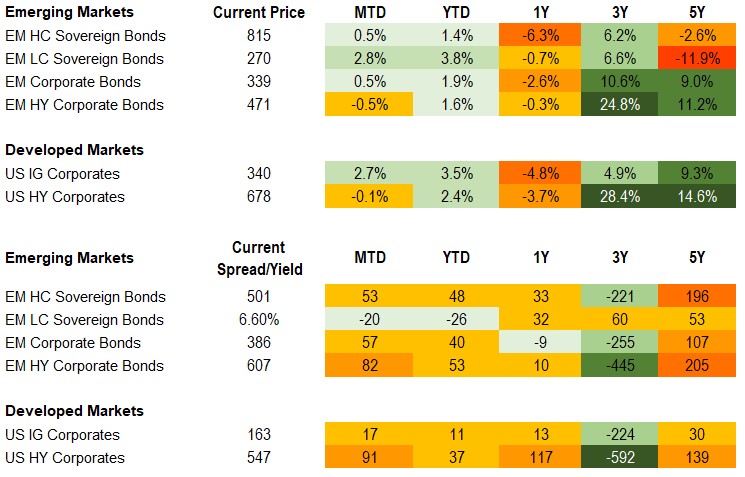
Equities
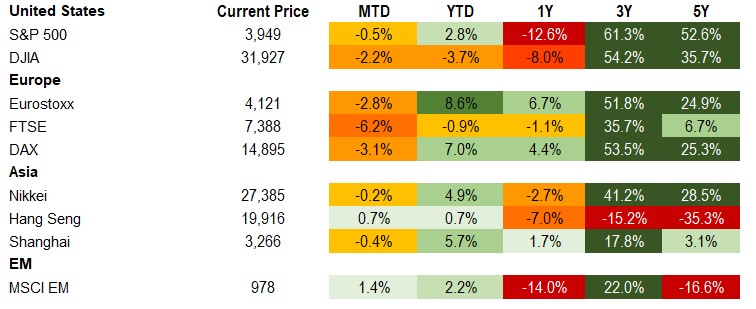
Commodities

Source for data tables: Bloomberg, JPMorgan, Gramercy. EM Fixed Income is represented by the following JPMorgan Indicies: EMBI Global, GBI-EM Global Diversified, CEMBI Broad Diversified and CEMBI Broad High Yield. DM Fixed Income is represented by the JPMorgan JULI Total Return Index and Domestic High Yield Index. Fixed Income, Equity and Commodity data is as of March 31, 2023 (mid-afternoon).
Emerging Markets Weekly Highlights
The Lula Administration reveals new fiscal framework; Bolsonaro’s return to Brazil unlikely to de-stabilize the country but carries higher political noise risks amid polarization
Event: This week, the Minister of Finance, Fernando Haddad, presented the long-awaited new fiscal rule for 2024 and beyond, devised by the Lula Administration to replace the existing constitutional budget spending cap. Meanwhile, former far-right President Jair Bolsonaro returned to Brazil after three months of self-imposed exile in the United States following his defeat to Lula in a very closely contested Presidential second round runoff.
Gramercy commentary: Given the intrinsic complexities and various assumptions associated with fiscal rules, it will take a few days for the market to fully digest the new framework unveiled by Minister Haddad. Nevertheless, our initial read and market reaction suggests a modest positive surprise relative to low expectations, especially among the local financial community in Brazil that has been highly skeptical about the ability and willingness of a leftist socially-minded Lula Administration to deliver fiscal responsibility. It is not a surprise that the new fiscal rule is less stringent than the exiting framework introduced during the Bolsonaro Presidency. It limits government spending growth to no more than 70% of revenues, which is a laxer requirement compared to the previous rule of capping real spending growth to zero, i.e., to the inflation rate. Overall, the new framework has some ambitious budget targets that might be challenging to comply with and appears to rely mainly on increasing public sector revenues rather than cutting costs. It will rely on expanding the tax base by revoking existing tax benefits that are seen as inefficient. Additionally, the government targets up to BRL150 billion (~$30bn) in additional revenues by the end of the year by tackling so-called tax distortions. In terms of timing, our expectation is that the proposed fiscal framework could receive the required approval by both chambers of Congress by June/July and enter into force in 3Q. A credible fiscal anchor in Brazil is essential for the monetary policy outlook and prospects for the vast local debt market. The Central Bank of Brazil (BCB) has been under heavy political pressure since the start of 2023 to start easing policy amid falling current inflation and the highest real interest rates in global EM. However, BCB’s policymakers have voiced concerns that fiscal loosening by the Lula Administration could lead to de-anchoring of medium-term inflation expectations in the economy and have pointed to a credible fiscal rule as a precondition for a rate-cutting cycle. Meanwhile, another important development for Brazil-watchers in global markets has been former President Bolsonaro’s return to the country. As a highly divisive figure in an already polarized political environment, Bolsonaro could catalyze higher risk for political noise/volatility, especially if Lula’s economic policies falter materially. However, we do not expect any potential noise from Bolsonaro’s return to local politics to raise to the level of materially de-stabilizing the country.
Argentina’s former President Macri announces he will not run for President
Event: Former President Mauricio Macri of the opposition coalition Juntos por el Cambio (JxC) announced this week that he will not run in this year’s Presidential election. At the same time, the opposition appears to have unified support around moderate candidate Diego Santilli in the Governor race for the Province of Buenos Aires. Meanwhile, President Fernandez and Minister of Economy Sergio Massa met with President Biden and the IMF this week to bolster support for the country in the context of pending board approval of the fourth review of Argentina’s EFF facility.
Gramercy commentary: Macri’s decision not to run, combined with the developments in the PBA race, are constructive as they are a step towards unification of the opposition. Additionally, this reduces the chances that Vice President and former President Christina Kirchner of the ruling coalition enters the race. On the Administration’s visit to the U.S., it remains unclear if the government was able to achieve amendments to targets beyond what was agreed at the staff level but we expect IMF Board approval to be forthcoming, despite aspects of policy that remain misaligned with the principles of the program. Meanwhile, Massa is seeking academic and opposition review of the decrees issued last week regarding the forced sale of public institutions’ dollar bonds and reportedly is considering a broadened new FX rate to address ongoing macroeconomic pressures. We expect the government to continue to attempt to muddle through to the election with a mixed and ad hoc approach to policy whereby economic conditions should drive further support for change.
Ecuador’s Constitutional Court gives green light to impeachment process against President Lasso
Event: The Constitutional Court allowed the formal impeachment request to remove President Guillermo Lasso from office to proceed, with six votes in favor and three against. The impeachment trial will now go back to the National Assembly for a formal process that is expected to last 45-60 days.
Gramercy commentary: A Constitutional Court relatively independent of political interference was perceived by investors as President Lasso’s best defense against the hostile National Assembly’s attempts to remove him from office. The magistrates’ decision to greenlight the process and return it to the legislature materially increases the probability that Lasso will be impeached. As a reminder, during the previous attempt to do so back in June 2022, the Assembly fell 12 votes short of the constitutionally required 92 votes to remove the President. This time around it should be easier to find the needed votes amid Lasso’s increasingly untenable political situations after his devastating defeat in a referendum in February and the Constitutional Court’s decision this week. Looking ahead, we see two scenarios as a possibility. Lasso could decide to pre-empt the National Assembly’s efforts to oust him, abolish the parliament and trigger early elections. However, the populist Corresita opposition appears most likely to benefit from such a decision. As such, we think a better alternative for the Lasso Administration would be to allow Vice President Alfredo Borrero, a Harvard-educated physician, to take over and attempt to finish Lasso’s term until 2025. Amid a tense political environment, this would likely require some uncomfortable political and economic compromises with the opposition but could be a way to improve governability. For Ecuador’s sovereign bonds that already discount what one could argue are “worst case” scenarios of medium-term debt distress that are at odds with the economy’s improving fundamentals, such a potential outcome could bring some welcome relief, in our view.
Tightening continues in South Africa and Mexico
Event: The South African Reserve Bank (SARB) lifted its policy rate by 50bps to 7.75% relative to market consensus for a 25bps hike with three out of five members in favor of a 50bps move and two in support of an increase of 25bps. Going forward, the committee did not signal an end to the hiking cycle and left the door open for further tightening. The rand rallied on the back of the move. At the same time, Mexico continued its hiking cycle lifting its policy rate by 25bps to 11.25% following last month’s surprise 50bps increase.
Gramercy commentary: In South Africa, the Central Bank is prioritizing the currency and inflation risk over already slowing growth. Inflation had been on a gradually downward trend since the middle of last year albeit with a small uptick in February’s print in the aftermath of rand depreciation. We expect a pause only when the domestic data and external environment are suitable. If March and April inflation data surprise to the upside, combined with continued FX volatility, another hike in May is likely. Conversely, if CPI prints are benign with a more muted external backdrop, a pause could be forthcoming. Banxico has taken a similarly hawkish tone throughout this cycle with its latest surprise to the upside last month. Sticky core inflation combined with still resilient growth dynamics have kept the bank vigilant and in tightening mode. Growth linkages with the U.S. suggest a more material slowdown in activity is likely as the year progresses opening the door for a pause in the coming meetings assuming core pressures begin to subside.
Egypt resumes hiking cycle while Ghana rate increase surprises to upside
Event: The Central Bank of Egypt increased its policy rate by 200bps to 18.25% after inflation surprised to the upside and an initial pause in the cycle. In Ghana, the Central Bank lifted its rate by 150bps to 29.5% in contrast to market expectations for policymakers to remain on hold. The cedi has reacted positively.
Gramercy commentary: Egypt’s initial pause in hikes somewhat contrasted expectations in the aftermath of anticipated inflation pass-through from the FX rate adjustments and already very elevated inflation. As such, resumption of the cycle is welcomed by the market. At the same time, pressure remains on the official FX rate, suggesting room for further depreciation in the coming days or weeks. Accordingly, we see room for additional hikes by the Central Bank, although we acknowledge somewhat elevated uncertainty over their approach. This comes in the context of the upcoming first review under its new EFF program with the IMF. While somewhat later than anticipated, we ultimately expect a successful review and disbursement next month. In Ghana, the authorities’ choice to hike in the context of improving inflation data helped cement sentiment around an orthodox approach and, on the margin, is supportive for impending IMF board approval on the country’s new ECF. Our base case is for IMF board approval in 2Q with increased momentum on bilateral and bondholder negotiations.
Emerging Markets Technicals
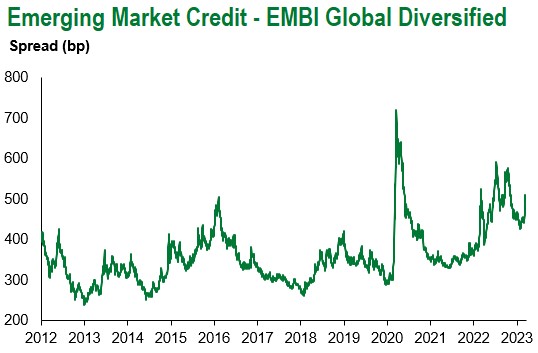
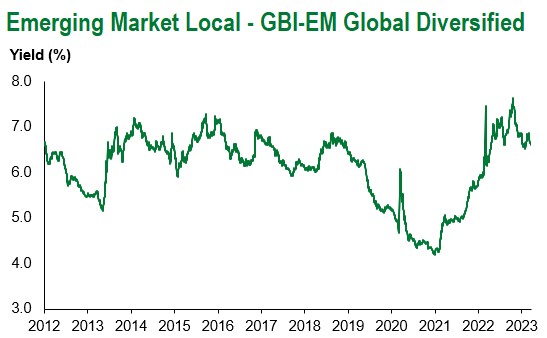
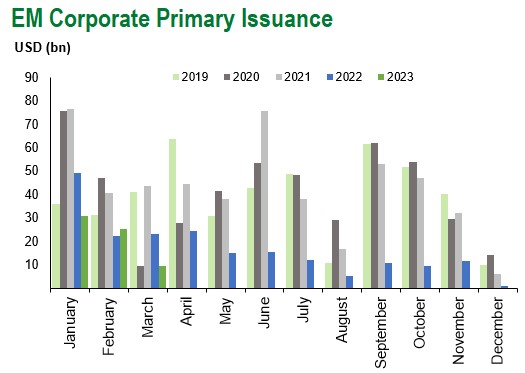
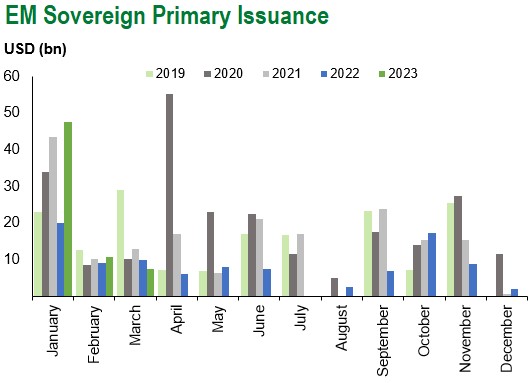
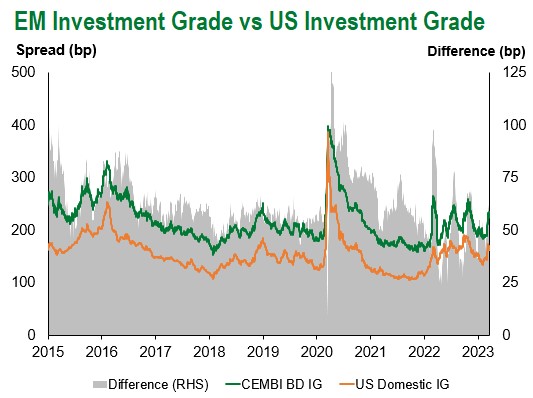
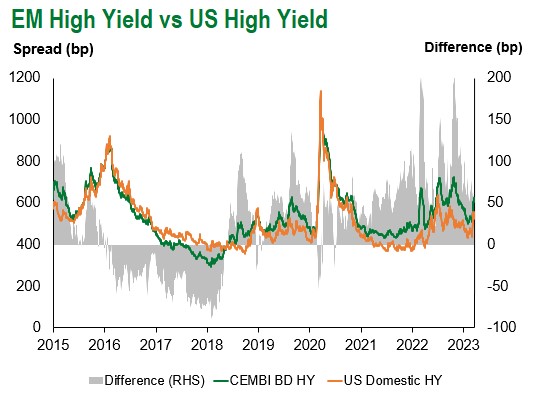
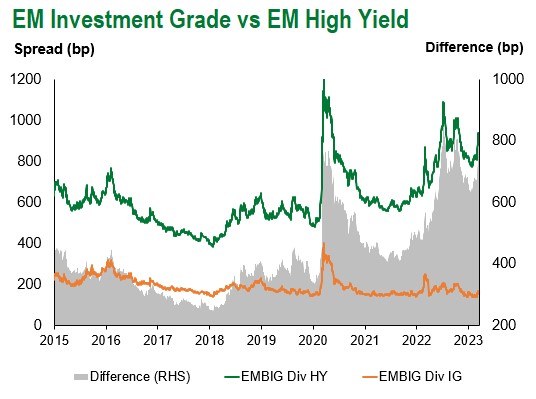
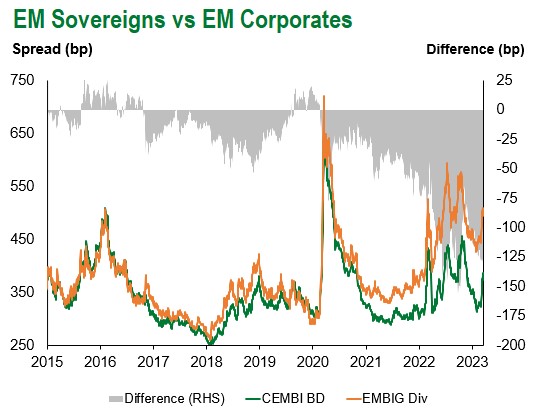
Emerging Markets Flows
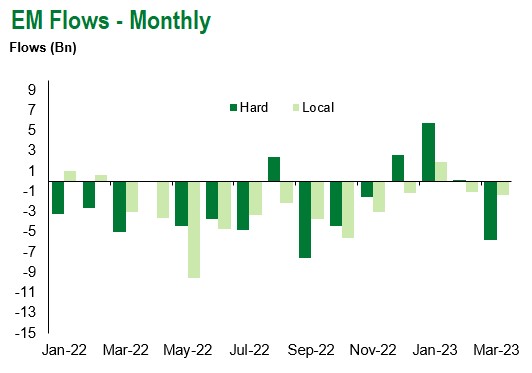
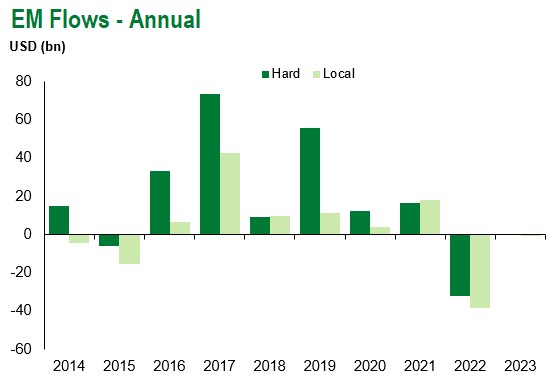
Source for graphs: Bloomberg, JPMorgan, Gramercy. As of March 31, 2023.
For questions, please contact:
Kathryn Exum, CFA ESG, Director, Co-Head of Sovereign Research, [email protected]
Petar Atanasov, Director, Co-Head of Sovereign Research, [email protected]
James Barry, Director, Deputy Portfolio Manager, [email protected]
This document is for informational purposes only. The information presented is not intended to be relied upon as a forecast, research or investment advice, and is not a recommendation, offer or solicitation to buy or sell any securities or to adopt any investment strategy. Gramercy may have current investment positions in the securities or sovereigns mentioned above. The information and opinions contained in this paper are as of the date of initial publication, derived from proprietary and nonproprietary sources deemed by Gramercy to be reliable, are not necessarily all-inclusive and are not guaranteed as to accuracy. This paper may contain “forward-looking” information that is not purely historical in nature. Such information may include, among other things, projections and forecasts. There is no guarantee that any forecasts made will come to pass. Reliance upon information in this paper is at the sole discretion of the reader. You should not rely on this presentation as the basis upon which to make an investment decision. Investment involves risk. There can be no assurance that investment objectives will be achieved. Investors must be prepared to bear the risk of a total loss of their investment. These risks are often heightened for investments in emerging/developing markets or smaller capital markets. International investing involves risks, including risks related to foreign currency, limited liquidity, less government regulation, and the possibility of substantial volatility due to adverse political, economic or other developments. References to any indices are for informational and general comparative purposes only. The performance data of various indices mentioned in this update are updated and released on a periodic basis before finalization. The performance data of various indices presented herein was current as of the date of the presentation. Please refer to data returns of the separate indices if you desire additional or updated information. Indices are unmanaged, and their performance results do not reflect the impact of fees, expenses, or taxes that may be incurred through an investment with Gramercy. Returns for indices assume dividend reinvestment. An investment cannot be made directly in an index. Accordingly, comparing results shown to those of such indices may be of limited use. The information provided herein is neither tax nor legal advice. Investors should speak to their tax professional for specific information regarding their tax situation.
